The de Rathe family
(Largely compiled from a number of sources by Lindsay Raitt. Additions and corrections are made as necessary).
The de Rathes occupied Rait Castle for a period of about 120 years from the late 1280s to at least 1405, i.e. mainly the 14th century, and we would normally expect there to have been four generations in this time: I can account for only three. I have so far discovered only seven de Rathes in Scottish-related documents who are potential members of the family, and all are associated with the North-east of Scotland.
The two earliest members of the family were the brothers Sir Gervase and Sir Andrew de Rathe, and the larger part of the documentary evidence pertains to them. It is their association with Rait Castle which originally marked them out as our earliest-known ancestors. In the next generation there is Johannes de Rayte, the Bishop of Aberdeen who is confidently related, Thomas de Rate, shield-bearer to King Robert II, who is probably involved, and I have third-hand, unsubstantiated "evidence from an unknown source" of an Archibald. In the third generation there is a Johannes de Rathe, active after the death of the Bishop, who may be related, and the fourth certain relation, Sir Alexander (de Rait), who was responsible for ending the family connection with Rait Castle and with Moray. The following paragraphs elaborate the story of each of these people.
Sir Gervase de Rathe is the earliest known member of the family. There is more evidence for Sir Gervase than for the others, although that amounts to only six or seven 'sources'. The details are contained in the Biography of Sir Gervase de Rathe, which relates, in summary, that Sir Gervase was the first known member of the family, he appeared in Moray in the 1280's, was intimately one of the group of Norman-origin aristocracy who administered the region, he was a military man with great power as the Constable of Invernairn, the major royal stronghold at the western end of the Moray coastal plain, and he was wealthy enough to have built himself a castle of little military significance. He is likely to have died without issue in 1297 since that is when Andrew was granted all his estates by Edward I.
Sir Andrew de Rait was the younger brother of Gervase [although George Bain in his History of Nairnshire (1893) says he is his son. Bain also states that Andrew was Constable of Nairn Castle at the time of Thomas Braytoft in Edward I’s reign.] He does not appear in the first Ragman Roll list of homages given to Edward I during his 1296 journey through Scotland to Moray, but as his history is all associated with allegiance to Edward I (and Cressingham, Edward I's treasurer in Scotland called Sir Andrew “your baronet” in a a letter to his master) he may already have given his homage oath before the King's Scottish journey. However, he does appear in the list of those who re-affirmed their allegiance at the 1296 Berwick Parliament as "Andrew de Rat knight of the County of Invernairn".

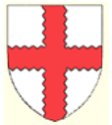
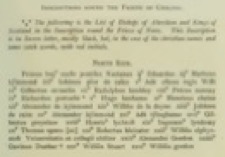
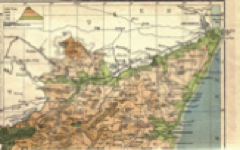

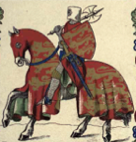
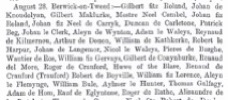

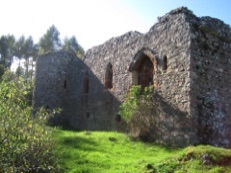
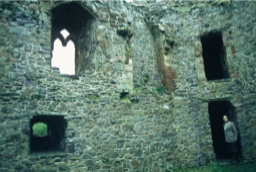
Rait Castle - summer 2014.
© Lindsay Raitt

There is mention in 1310-12 of both Geoffrey de Raaite and Thomas de Raaite receiving payments for their squires and horses in Perth.
1310 July 9-21. The Chamberlain of Scotland:—For money paid to
Geoffry de Raaite [and others] for victuals bought from them,
21st July, 76s. 8d. [Exchequer, Q. E. Miscellanea ( Wardrobe), No. 19/14]
1310 July. Payment to Geoffry de Raaite (Raat) for his esquire in Perth
and his horse
1312. Payment to Thomas de Raaite, esq. Perth, for his horse.
We find that Johannes de Ratis witnessed a lease of property in the village of Glesbany in 1321, while Johannes de Rate made an agreement with the abbot and convent of Scone in 1332. He has been included above.
The Anonimalle Chronicle, a manuscript written at St Mary's Abbey in York, has a list of the Scots who were casualties at the Battle of Crécy in Northen France in 1346. The list notes that one of those killed was Sir Alexander de Rathe.
In 1367 a William de Raat was witness to a charter of Agnes de Montfort giving to Simon Scajlock of Montrose half a davoch of the land of Slains.
Alexander of Rath witnessed charters in Ayr in 1337 and 1378. Hugh de Rath was appointed coroner of the sheriffdom of Ayr by Sir John Lindsay (Great Chamberlain of Scotland) and had a Crown charter of confirmation in the second year of Robert II (i.e 1371-1372). In 1368 Hugoni de Rathe (Rait) received payment as clerk of the Queen’s Wardrobe. In 1373 he is also recorded as the collector of a contribution from Cuningham. In 1375, Hugonis de Rate is receiving payments as a bailie in Montrose - presumably this is the same chap. Alexander Raith is a bailie in Ayr in 1431.
Certainly Hugh, the coroner in Ayr, might have been a son of Roger de Rathe of Ayr or even Alexander of Rath. The old lands of Raith in Ayr are mentioned in the year 1264 - which ties in well with Roger de Rathe and possibly the others too. But did Roger, who seems to be the earliest person associated with the place and who may very well have been the possessor of these lands of Raith, give his name to his estates or take his name from an older existing dwelling there (a fortification perhaps?).
These de Rathes may even have been connected to the Nairn de Rathes - possibly cousins, or perhaps emmanating from a common Anglo-Norman ancestor. However, it is really too early to speculate on the precise relationship of all these individuals.
There is no extant direct, or primary, documentary evidence which might have told us about the people who lived in Rait Castle. It is possible that the "charter chest" of documents, title-deeds to the lands of the property and other legal papers, was destroyed in the battles over the ownership of the Castle and barony in the period after 1400, which resulted in the degradation of the Castle into the ruin of today. Alternatively, the charter chest, like those of other families in Moray, may have been deposited "for safety" in the Chartulary of the Cathedral in Elgin, only to be destroyed when Alexander Stewart, the son of the King and known as 'The Wolf of Badenoch', burnt the Cathedral in 1390 in an act of revenge. So we are dependent on secondary evidence, on passing mention in the documents of other families or authorities which have been saved elsewhere.
It is worth pointing out that George Bain states in his History of Nairnshire (published 1893) that during the minority of Angus Mackintosh (about 1274), the Cumings took possession of Raite and Meikle Geddes and other lands which belonged to Mackintosh. As Norman knights, they dropped their surname and appear in the records of the period simply with the territorial title "De Rathe." The correct name of the Rait Castle family seems to be "de Rathe", though it has also been rendered as "de Rate", "de Rayte" or "de Rat". Unfortunately, most of the 19th and 20th century historians transliterated this for their publications as "de Rait" for all the members of the family, regardless of the original documentation. The result has been some confusion, including what I believe to be an incorrect derivation of the family name, holding "Rait" as a corruption of the Celtic word "rath" meaning a fortification (or defended farmstead, depending on which "authority" you prefer to believe). [See additional definitions, meanings and explanations under Raitt Name.] This derivation may well be correct for the place-name Rait given to the Castle, but it is not the derivation of "Rathe" as the family name. I prefer to believe that, as the first named individuals in the family were intimately involved with the group of Norman-origin aristocracy and administrators imported by the English-educated Kings of medieval Scotland, the territorial designation "de Rathe" probably refers to a location in Northern France, as has been evaluated for so many other of the "Norman invaders" of Scotland. The de Rathes lived amongst the Norman French speaking aristocracy of Moray, and are most unlikely, on status grounds alone, to have taken their name from a Celtic word, Celtic being the language of the peasantry over which they ruled. It was only in the 15th century that the territorial connection to "Rathe", wherever that was, was replaced by the surname "Rait", presumably derived from the family's former association with Rait Castle and its property.
However, this is not the end of the de Rathe story. To establish where the de Rathes came from originally we need to know more about their antecedents - Gervase and Andrew will probably have had a father and grandfather with the same surname, and there may be other brothers, uncles and cousins waiting to be discovered. The search for more data would need to take cognizance of records from more southerly areas of Scotland, and from England with dates in the 13th and 14th centuries, and earlier if possible. A very few such occurrences have already been found, and it is to be hoped that the list may be expanded:
The Battle Abbey Roll (listing knights who came to England in 1066 with William the Conqueror) includes the name Rait and mentions several people bearing the same name or similar including Jordan de Raat who owned lands in Lincolnshire “in the time of Henry III”, i.e. 1216-1272.
The Ragman Roll list of the attendance at Edward I's 1297 Parliament includes a Roger de Rathe from the county of Ayr. Like Andrew de Rathe he paid (or reaffirmed) homage to Edward on 28 August 1296 at Berwick on Tweed.
Sir Alexander (de Rait) is confidently identified with the third generation of the de Rathe family. Unfortunately, I have not discovered original documentary proof, and we are dependent on "local tradition" expressed in a footnote to the publication of the Cawdor papers, which says that "Sir Alexander killed Andrew Calder, the Thane of Cawdor, and that the name Rait (i.e. "de Rathe") disappeared from Moray about this time". The date of the event is estimated from a document dated 1405 preserved in the Cawdor papers which gave Cawdor castle and properties, and the title Thane of Cawdor to Andrew Calder's son Donald, but does not name Sir Alexander as his father's killer. "Tradition" also says that Sir Alexander fled to Kincardineshire and was given refuge by the Earl Marischal, Keith of Dunnottar. In the absence of original documentary evidence I do not know if Sir Andrew used the name "de Rathe" - it seems likely that he did. Like his possible father, Sir Archibald, it is likely that Alexander was the eldest son and holder of the Rait properties.
In the survey of the Province of Moray (1798), “chiefly extracted from Mr. Shaw, is the following account of the family of Calder, whose writs he had inspected. The surname of Calder is local and is ancient. Dovenaldus, Thanus de Calder, was one of the estimators of the baronies of Kilravock and Geddes in 1295. His son William had from Robert Bruce in 1310 the thanedom of Kaledor, for the usual services in the time of Alexander III. His son Andrew was killed by Sir Alexander Raite, whose son Donald was served heir to his father in 1405, and in the succeeding year was saised in the offices of Sheriff and Constable of Nairn. His son William was insest in 1442. In 1450 he built the Tower of Calder. by a royal licence.”
One could assume that Alexander de Raite, then, had been, like his predecessors Gervase and Andrew, Constable of Nairn Castle and this office was forfeit to the Calders (Cawdor).
Johannes de Rathe is included in the list of witnesses to a charter of the Bishopric of Moray, dated 1398, concerning property in Elgin. This is not the same Johannes as the Bishop, whose death in 1355 is well-documented, and the date of his occurrence in the records would suggest the second, or churchman, son of the next, third generation of de Rathes.
On the basis of all this fragmentary evidence, the structure which I propose for the "de Rathe" family of Rait Castle is:
• Gervase and Andrew, brothers, with Gervase being the elder.
• Sons of Andrew - a possible Archibald as eldest son in possession of the Castle, his brothers being John, the priest, who became Bishop in Aberdeen, and Thomas who became the King's shield-bearer and was based in Kincardineshire.
• Sons of Archibald (if he existed) - Alexander who held and lost the Castle, and his brother John.
After the flight of Sir Alexander to Kincardineshire, presumably taking all his family with him as there were no de Rathes in Nairnshire thereafter, the Rait family history is the story of the Raits of Hallgreen Castle, Kincardineshire.
The next evidence of Sir Andrew comes in June 1297 when Edward assigns to Andrew all the lands in Scotland of Gervase "his brother". [He may also have inherited Gervase’s position as Constable of Nairn Castle.] At about this time Andrew was travelling between Moray and London as the courier between the authorities charged with the defence of Moray who were pleading with Edward for assistance in countering the rebellion led by Andrew de Moray, and Edward who declined to give them additional assistance. A letter to the King, dated 24 July 1297 in Inverness, from Henry bishop of Aberdeen, John Comyn earl of Buchan, constable of Scotland, and Gartnet son of the Earl of Mar gave an account of their putting down an insurrection in Moray, and asked credence for Sir Andrew de Rathe. The Countess of Ross had aided them, for which they commend her to the King.
That Andrew survived the first part of the War of Independence is attested by his signature, as Andrew de Raath, knight, witnessing a charter of John Comyn, the Earl of Buchan, dated 1299 relating to the resignation of the Archbishop of Aberbrotock.
Andrew makes another appearance in the documentary record in 1304 when he was in charge of the escort provided for two of Edward's clerks collecting taxation data in the Moray region, information which Edward required to allow him to re-fill his coffers after his military adventures elsewhere.
He is also mentioned in other official documents regarding payments for his services.
1304-5 Discharges – To Sir Andrew de Rathe knight, for his debts in the Wardrobe by Sir Walter de Bedewynde's (Cofferer of the Wardrobe). To said Sir Andrew, associated with said …. John (Sir John de Drokenesford keeper of the Wardrobe) to make these extents at 3s. a day, for himself and his esquire from 1st May till 31st December [1304], 184 days, 27l. 12s.
Also to Sir Andrew de Rat knight, per diem ut supra for his own and his esquire's pay from 1st November till 31st January anno xxxiii, 92 days, 13l. 16s.
And finally, Andrew's heraldic symbol has also been preserved, and is described as a "argent, a cross invecked gules" (invecked and engrailed are heraldically interchangeable symbols).
In summary, Sir Andrew acted as a good servant of Edward I. He survived his older
brother, and inherited his estates. It has been noted that when King Robert the
Bruce took full possession of the Scottish realm after Bannockburn in 1314, he
recognized that he would require a considerable corps of experienced administrators
to run his kingdom, and so he pardoned many of the aristocracy who had opposed him,
restoring their land rights. It is probable that Sir Andrew was one such, and that he
returned to Rait Castle and initiated the family which succeeded him at Rait.
Johannes de Rayte is firmly documented in the Register of the Diocese of Aberdeen as their Bishop from 1351 to 1355, when he died and was buried in the choir of the Cathedral. In 1342 he had been made an archdeacon of Aberdeen (with a canonry in Bruges), and in 1348 he was given a precentorship at Elgin Cathedral in Moray. He is very probably same man as the Johannes de Ratis who witnessed a lease on the property of Glesbany in 1321, and the Father Johannes de Rate who made an agreement with the Abbot of Scone, Perthshire which is dated 1332 The dates attributed to him would be consistent with his being a son of Sir Andrew, and as the churchman he would probably have been the second son.
Thomas de Raythe or Rate was probably the most prominent and wealthiest Rathe of his generation. From one of his property charters granted by the King, we know that Thomas was the shield-bearer for King David II. Between the years 1369 and 1383 he was involved in a number of transactions involving properties in Kincardineshire and Forfarshire (Angus), and he was known as Rate of Uras, which was his primary land-holding, lying between Dunnottar and Hallgreen Castles in Kincardineshire. The documentary evidence links him to the family of de Rathe of Moray only by his name, but a tenuous association may be the record of an acknowledgment by Thomas de Rate in 1382 of a receipt for money accepted on behalf of the bailie of Avoch in Nairnshire due on lands of Avoch and Eddyrdor in Invernessshire. With these dates, and with the military connotation of his function as shield-bearer, Thomas could have been the third son of Andrew de Rathe. He seems to have died about 1390. (See also under Illustrious Raitts - Grantees and Raitt Residences - Dunnottar).
Sir Archibald has yet to be revealed in the documentary record. I have a third-hand story "from an unknown source" of a Sir Archibald who was supposed to be the father of Sir Alexander de Rathe. I have found no confirmation of his existence, but it is of interest that the history of the Rait family included in Burke's Landed Gentry says that it was a Sir Archibald (rather than Alexander, and I suspect a misreading of evidence) who was forced to flee from Moray for killing the Thane of Cawdor. These are very tenuous indications, but I am tempted to include an Archibald in the family tree simply on a "no smoke without fire" basis until the "unknown source" is discovered. As his supposed son was evidently based at Rait Castle, it is likely that this supposed Archibald was the eldest son of Sir Andrew, inheriting the baronetcy and the Rait properties in Nairnshire.
